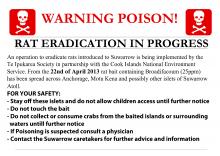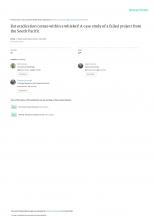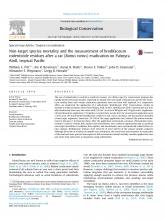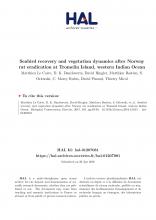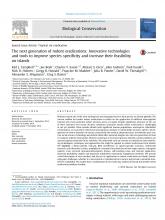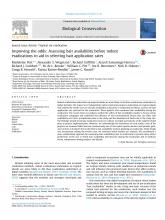Special Issue Article: Tropical rat eradication. The next generation of rodent eradications: Innovative technologies and tools to improve species specificity and increase their feasibility on islands. Biological Conservation. Volume 185, May 2015


Island and Ocean Ecosystems, BRB
Available Online
Baxter. G.S.
,
Beek. J
,
Campbell K.J
,
Eason C.T
,
Glen A.S
,
Godwin. J
,
Gould. F
,
Holmes. N.D
,
Howald. G.R
,
Madden F.M
,
Ponder J.B
,
Threadgill. D.W
,
Wegmann. A.S
2015
Rodents remain one of the most widespread and damaging invasive alien species on islands globally. The current toolbox for insular rodent eradications is reliant on the application of sufficient anticoagulant toxicant into every potential rodent territory across an island. Despite significant advances in the use of these toxicants over recent decades, numerous situations remain where eradication is challenging or not yet feasible. These include islands with significant human populations, unreceptive stakeholder communities, co-occurrence of livestock and domestic animals, or vulnerability of native species. Developments in diverse branches of science, particularly the medical, pharmaceutical, invertebrate pest control, social science, technology and defense fields offer potential insights into the next generation of tools to eradicate rodents from islands. Horizon scanning is a structured process whereby current problems are assessed against potential future solutions. We undertook such an exercise to identify the most promising technologies, techniques and approaches that might be applied to rodent eradications from islands. We highlight a Rattus-specific toxicant, RNA interference as species-specific toxicants, rodenticide research, crab deterrent in baits, prophylactic treatment for protection of non-target species, transgenic rodents, virus vectored immunocontraception, drones, self-resetting traps and toxicant applicators, detection probability models and improved stakeholder community engagement methods. We present a brief description of each method, and discuss its application to rodent eradication on islands, knowledge gaps, challenges, whether it is incremental or transformative in nature and provide a potential timeline for availability. We outline how a combination of new tools may render previously intractable rodent eradication problems feasible.
